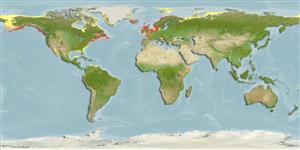Common names from other countries
Environment: milieu / climate zone / depth range / distribution range
Ecologie
; diepteverspreiding 0 - 55 m (Ref. 83435). Temperate; 85°N - 15°N, 180°W - 39°E
Atlantic Ocean, Eastern Pacific , Arctic and the Mediterranean Sea. Subtropical to polar.
Length at first maturity / Size / Gewicht / Leeftijd
Maturity: Lm ? range ? - ? cm Max length : 2.0 cm TL mannelijk/geslacht niet bekend; (Ref. 822)
Assumed maximum length from Ref. 822. This species is found in infralittoral areas particularly in gulfs and estuaries. It is known as an omnivore, predator and a scavenger. It feeds on planktonic and minute detrital food items through either suspension or deposit feeding (Ref. 87872).
Life cycle and mating behavior
Geslachtsrijpheid | Voortplanting | Kuitschieten | Eieren | Fecundity | Larven
This species has separate sexes and are difficult to distinguish externally.
Turgeon, D.D., J.F. Quinn Jr., A.E. Bogan, E.V. Coan, F.G. Hochberg, W.G. Lyons, P.M. Mikkelsen, R.J. Neves, C.F.E. Roper, G. Rosenberg, B. Roth, A. Scheltema, F.G. Thompson, M. Vecchione and J.D. Willams. 1998. (Ref. 1667)
Status op de Rode Lijst van het IUCN (Ref. 130435)
Status bij CITES (Ref. 108899)
Not Evaluated
Not Evaluated
Gebruik door de mens
| FishSource |
Tools
Internet-bronnen
Estimates based on models
Preferred temperature
(Ref.
115969): 5.3 - 13.2, mean 9.6 (based on 636 cells).
Kwetsbaarheid
Low vulnerability (10 of 100).
Prijsklasse
Unknown.
